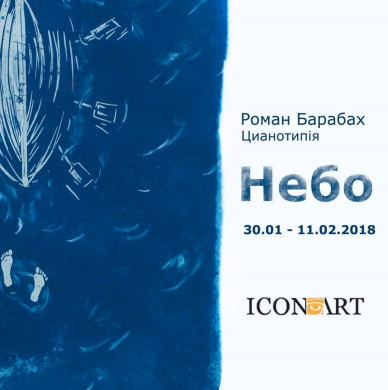Heaven
An attempt to merge photograph and icon
The worldview of Roman Barabakh entails a permanent dialogue with the fundamental Christian ideas, themes and values. The artist rethinks his subjects from the perspective of Christianity and shapes his style in the context of religious symbolism. Roman’s two passions are iconography and photography. Heaven is the word in which the two merge. What is heaven, and how is it, as seen by Roman Barabakh?
Heaven is a provocative yet mystique title for a debut exhibition. The provocative aspect comes from the artist himself. By choosing it, he also chooses a challenge of accomplishing an established heavenly height. The mystique side is for each of us as it encompasses an endless array of obvious and underlying meanings to be read and comprehended.
The artist used the cyantope or blueprinting technique to create the works displayed here. It was used in the early mid-19th century photographs. The images are exposed to the light and oxidized, changing colors from green to blue. The blueness transfers to the print image on paper. Roman interprets this transformation of colors that does not involve the artist directly as a sort of sacred process that has a symbolic sense. He reads the revelation of the hidden blueness as a sign of the invisible Divine spark sheltered in the work of art, as well as human soul. The light that liberates the sky color from the heavy material, the oxidized metal, serves as a metaphor for the Christian catharsis, purification of the soul and approximation to God. This original and deeply symbolic interpretation of a photography printing technique allows Roman to merge the essentially opposite concepts of photographs and icons.
Icon painting is the most conservative genre in terms of standards for composition, palette, symbols and the hierarchy of images. An icon rethought as a photograph allows the artist to discover a range of unexpected interpretations of established standards. First and foremost, these affect the composition and the angle of the image, something in which icons and photographs are often on the opposite poles. For instance, an image from the back is unacceptable in an icon yet it is one of the most popular angles in photography. A chronicling iconographer, Roman chooses unexpected angles: he portrays Jesus walking on water from under water. He uses a bold move, cinematographic in nature, to underline or revive the understanding of a miracle. That was how the fish, the only creatures God did not punish in the Deluge, watched the biblical scene from under the surface of the Sea of Galilee. The hands with stigmata are portrayed palms down, as if in a gesture of blessing, and as if they were his own hands as well.
Sacred images reinterpreted through cyantope emerge as a sort of photographs of saints. The image of Jesus Christ on the veil of Saint Veronica, the Mandylion, turns into a print through the lens of the photographer, a graphic artist. This technique turns the artist into a chronicler of biblical scenes and brings the genre of photography to the level of sacral images. This unexpected discovery -- which the artist himself may have not yet comprehended in full -- reveals a deeply symbolic link between photography as a reflection of a realistic image and iconography as a symbolic reflection of divine images.
Anastasiya Simferovska
